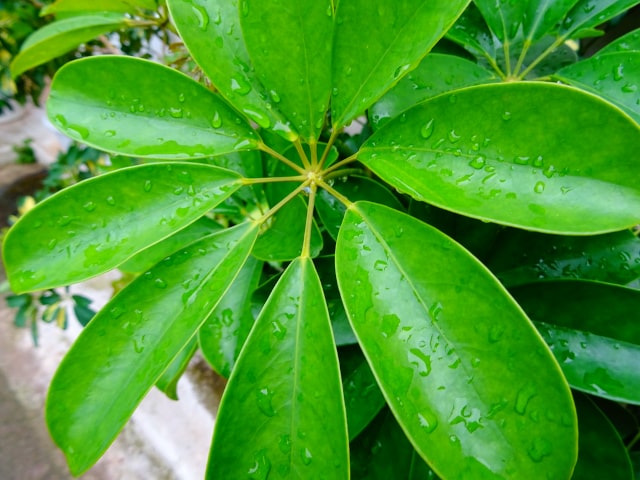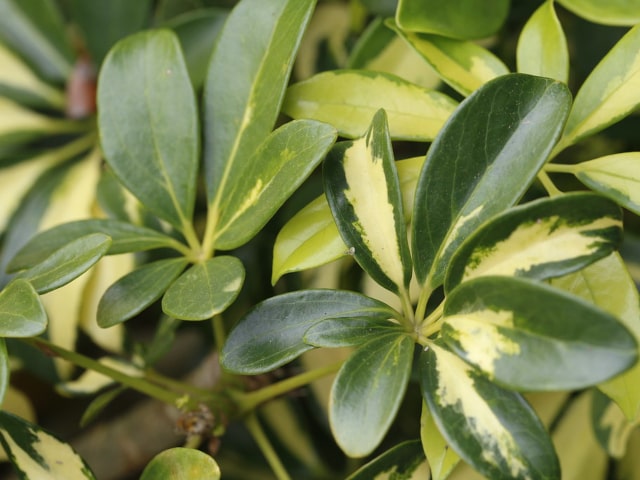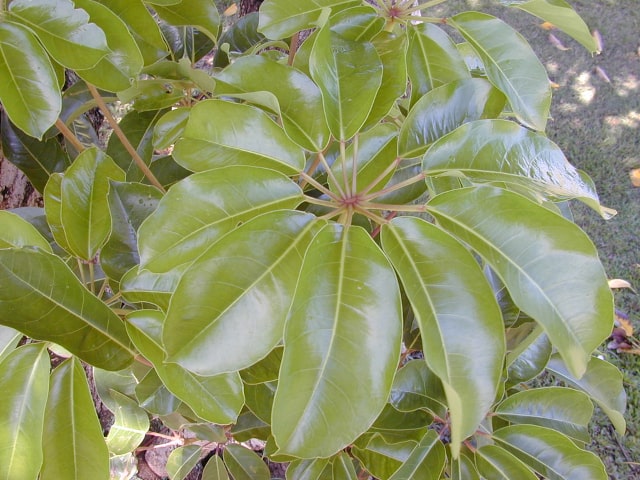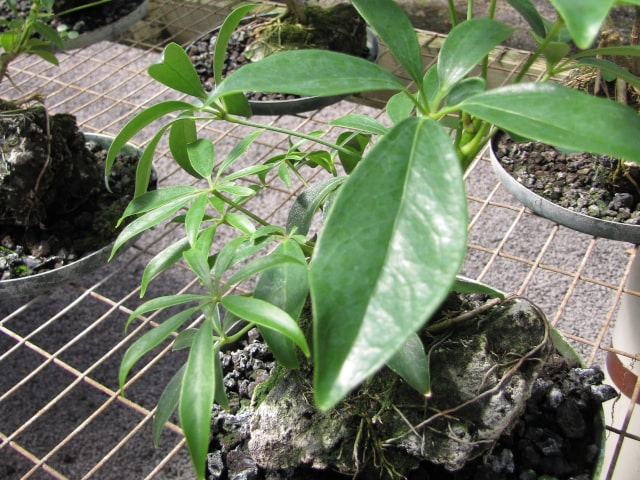
Umbrella plant (Schefflera / Heptapleurum, scientific name Schefflera Arboricola) is a popular houseplant. It is commonly known as the Dwarf umbrella tree. These beautiful plants can successfully be grown indoors. One of the best things about them is that they can easily be kept to a small size. They will grow around 4 to 8 feet tall indoors. They are also easy to care for so it is not difficult to make your umbrella plant thrive inside your home.
These plants originate from Taiwan. They are known under numerous names, such as umbrella plant, dwarf umbrella tree, Queensland umbrella tree, Gold Capella, octopus tree, and more.
Umbrella Plant Description
Umbrella plants are multi trunk trees. These beautiful plants can grow around 10 feet outdoors so they need to be pruned if you want to grow them inside your home. Pruning and topping is essential care for umbrella plants.
This tree's close relative, Schefflera Actinophylla, need to be planted carefully since it has a very invasive nature. In fact, it is seen as weed in some areas, so be careful if you wish to grow this one in your home.
Most umbrella plants have two or more trunks, though it is not unheard of to find those with only one trunk. They typically have multiple branches with palmate compound or whorled leaves. You will recognize them by their distinctive look: they resemble fingers coming from the stalk. They typically have 4 to 12 leaflets. This gives them an umbrella spoke appearance, hence the name.
The plant also has glossy leaflets that are nearly oval in shape. These leaflets are a few inches long and several inches wide. This size depends mainly on the age and size of the tree.
Common Varieties of Umbrella Plants
There are some common varieties of umbrella plants. There are 3 most popular varieties of these plants that are commonly grown in homes: variegated Gold Capella, plain green leafed and dwarf sized umbrella plant. These are by far the most common varieties of umbrella plants you can find in garden centers and other specialized stores. Another thing to keep in mind is that umbrella plans are often grown as bonsai trees.
There are some slight differences between S. arboricola and S. actinophylla, so it is best to always ask staff at the store to help you choose the right one. However, keep in mind that both types require the same care conditions so it might not make so much of a difference, except that S. actinophylla tends to be more invasive, so be careful about that.
Umbrella Plant Care Requirements
Umbrella plants are considered easy to care for in the home. This is why even beginners can consider growing umbrella plants in their home. All you need to provide to your plant is some basic care and maintenance. This is typically sufficient to make an umbrella tree happy.
In fact, these plants thrive when left alone. Less is truly more with them, particularly when it comes to watering and feeding. Giving them too much water or fertilizing too much will actually cause numerous problems, so keep this in mind. However, if you add only a little more than needed it will not cause serious problems so you don't need to stress too much about it.
One thing you need to remember, though, is that older umbrella trees typically need to be supported by a moss stick or a stake. In case you wish to use a moss stick make sure to choose the one that has matured enough and has aerial roots. The only way to prevent this is to regularly prune and pinch your umbrella plant.
Warning: Poisonous for Pets!
One important thing you need to remember about umbrella plants is that they are toxic to cats and dogs. Keep this in mind if you wish to grow umbrella trees in your home. It is best to grow them only in places where your pets don't have access to.
This plant is mildly toxic when ingested by cats and dogs so if you notice that your pet is unwell, make sure to take them to the vet immediately.
Flowering
When grown outdoors in warmer climates, the umbrella plants produce bright red flowers that resemble tentacles. The flowers grow on long stems above the foliage. This is where one of the popular names for the plant comes from: octopus tree.
However, keep in mind that it is very difficult to make your umbrella plant bloom indoors. This is important to remember if you want to keep your tree indoors at all times.
Repotting Your Umbrella Tree
Keep in mind that it is important to repot your umbrella tree once in 2 years. During repotting, it is vital to provide your plant with anew potting mix. Always repot during spring. To stay on the safe side, avoid fertilizing your plant for one month after repotting. The reason for this is that new potting mixes typically contain all the nutrients a plant need so adding more fertilizer will just lead to over-feeding.
When choosing a new container, make sure to pick the one that is solid and heavy enough. This is important because it needs to be strong enough for the mature tree.
Propagating Your Umbrella Tree
These plants are not easy to propagate, so keep this in mind before you try. Propagation is typically done by taking a 4 to 6 inch stem cuttings during spring. It is important to remove all the leaves from the cuttings, save from one set. It is also important to make sure that the node is available: this is where the new growth will sprout from.
It is also important to use rooting hormone on the cut that you will place in the soil. Make sure to pot the cutting in the container that you can cover with a plastic sheet.
Another way you can go is to use a propagator. You will need to keep these at the exact temperatures of between 65 degrees F and 75 degrees F (18 to 24 degrees Celsius). It is also important to provide them with bottom heat. This will all improve your chances of success.
During the propagation process make sure to never over-water the soil. Over-watering will make the cuttings rot. It is best to wait until you notice plenty of new growth until you start providing basic care for your new plant.
Pruning
Umbrella trees need to be pruned. They tend to grow very fast so pruning is a must, especially if you want to grow your tree indoors. In case your umbrella tree becomes leggy or if you want to make it look bushy, simply pinch the growing tips of the plant.
One good thing about umbrella trees is that you can basically prune them as much as you want and it will bring the new growth the next spring. It means that you can rarely go wrong or over-prune it.
Photo credit: Sotiris Marinopoulos




2 Comments
Is it possible to revive an umbrella tree that's been in a cold greenhouse through the winter with just one branch and 5 leaves that look dead?
My mother and I just propagated 8 of these by taking 12 inch branches from overgrowth and dropped them in a clear vase of water. In a month they had 1 inch roots blooming down the entire length of stem that was submerged in the water (about 6 inches.) We tried two ways. One with a rooting hormone jell mixed in the water and one in used aquarium water. There were no differences in the two methods as both were extremely effective. We never changed the waters, just added more plain tap water. Next we will try with just plain tap water.